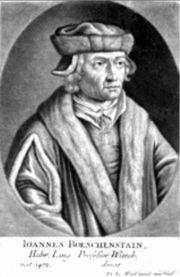Johann Burchard
John Burckard (sometimes Burchard or Burckardus, Italian Burcardo; * 1450 in Niederhaslach in Alsace, † May 15, 1506 in Rome) was prothonotary of the Holy See and 1484-1503 Master of Ceremonies at the Roman Curia. Importantly, it is because of its editions of liturgical books and his ceremony diary Liber notarum ( 1483-1506 ), which provides an essential source of life at the court of the popes of the Renaissance.
Life
Burckard came from a poor family and was educated at the Collegiate St. Florentius in his Alsatian birthplace. First, he was clerk in the Vicar General of Strasbourg, but from where he fled because of a forgery. Since 1467 he lived in Rome, from the year 1475 he has been a member of the court ( Familiar ) by Pope Sixtus IV and was mentioned in the following year the priesthood. He earned the customs of his time accordingly, numerous benefices in Alsace ( 1477 and got the citizenship of the city of Strasbourg awarded ), including the provost of Moutier- Grandval; as it was also common for the benefices were managed by proxy, only the revenue came to the owner.
In 1483 he was appointed as the successor of Agostino Patrizi Piccolomini, papal master of ceremonies. As such, he was responsible not only for the entire liturgy, but also for the alignment of all other ceremonies at the papal court.
In Rome, built Burckard the still existing Casa del Burcardo ( Via del Sudario 44 ) with the Torre Argentina ( German: Strasburg tower), the Largo di Torre Argentina gave his name. 1503 he was appointed Bishop of places and Civita Castellana. His grave is in the church of Santa Maria del Popolo in Rome.
His diary " Liber notarum "
For use at the papal court he put on a notebook in which he recorded the events at the Curia in detailed descriptions; but not only the protocol-related duties, he led book but also on discussions with the popes, cardinals and ambassadors is reported therein. They extend over the time of the Popes Innocent VIII, Alexander VI. , Pius III. and Julius II. particular, the descriptions of the states at the court of the Borgia Pope Alexander VI. seen as major source for the proof of its decadence.
These records, known as Liber notarum were not published until about four hundred years after the death of the author. The authenticity of the complete work was first doubted by de Roo, later by Monaldi & product range. The reasoning for this is the lack of any hand-written original texts and the kollageartige composition of the various texts that suggest a later insertion of foreign texts denunciation of the Borgia pope. In addition, this edition contains a proven record of plagiarism, a copy of a piquant story from the Decameron of Giovanni Boccaccio.
Works
- Liber notarum E. Celani (ed.): Liber Johannis Burckardi Notarum from anno 1483 usque ad annum 1506 ( Rerum Scriptores italicarum 32). 2 vols Città di Castello -Bologna from 1910 to 1912;










